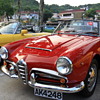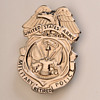Posted 10 years ago
 pw-collector
pw-collector
(297 items)
This posting is in response to gargoylecollectors posting on Smith & Wesson Handcuffs (http://www.collectorsweekly.com/stories/137795-smith-and-wesson-handcuffs?in=activity).
Posted here is a set of Smith & Wesson Model 103 Stainless Steel handcuffs, introduced in 1979 when S&W moved their handcuff manufacturing from the Springfield, Mass. plant to the Houlton, Maine plant. The lock case is constructed with exposed rivets for added strength. They feature a self-locking single lock and a manual double slot lock that is accessible from both sides. To double lock, you insert the small peg on the top of the key into the double lock slot and slide it to the center of the cuff to prevent further tightening. They were finished with a brushed stainless steel finish. They were also offered with the earlier push-pin double system that had a push-pin on the edge of the lock case that was pushed in with the small peg on the top of the key. The slot on the face of the lock case was eliminated on this version. In 2011 when S&W changed all their handcuffs to be constructed using rivets to join the lock case together instead of the old brazing method, they added a (-1) to the existing model numbers. So the Model 103 is now the Model 103-1 and can be currently ordered.
Photo 1 & 2 are of the Model 103.
In 1961 S&W introduced their first line of stainless steel handcuffs. They were an all stainless steel constructed handcuff weighing 8-1/2 ounces. They were constructed using the brazing method to join the lock case together. They were offered in two models. The Model 936, a polished stainless steel and Model 938, a regular (dull) stainless steel finish. Each model had the push-pin double lock system. On the right cuff front jaw (the movable arm) by the pivot hinge there is a small "s" stamped. It is also stamped on the left rear jaw (they did not stamp this "s" on the Model 103's). The Model 936 was deleted from the product brochures sometime between 1971-1974. The Model 938 was continued until 1979.
Photo 3 shows the front view of the Model 936 & you can see the small "S" on the jaw by the pivot hinge.
Photo 4 shows a close-up of the small "S" stampings on the right front and left rear jaw, & the finish variation between the Models 936 & 938.
gargoylecollector, I hope this is of some help to you in correctly identifying your handcuffs. Like I mentioned in your post, if your handcuffs do not have this small "s" stamp, they are not a stainless steel model and are probably an all steel constructed with a nickel finish Model 90.
Dave





























This is a link to gargoylecollectors post
http://www.collectorsweekly.com/stories/137795-smith-and-wesson-handcuffs?in=1137
Thanks again PW!!!!!!!!
Nice description pw ! Glad to see you too !!!
Your welcome again gargoyle. Let me know if this answered your questions.
Thanks for the appreciations:
aghcollect
gargoylecollector
Kerry
Ken
Manikin
mikelv85
walksoftly
Mine are model 90's
I got them out this weekend and they look like the ones in the 3rd pic,but no S.
That nickel plating must be good,there isn't a speck of rust,they cleaned up great.They were found in the loft of an old barn.
Thanks gargoyle, check out this post on the Model 90.
http://www.collectorsweekly.com/stories/138275-smith-and-wesson-model-90?in=1137
Dave
Thanks for the appreciations:
southcop
AzTom
Jewels
geo26e
Thanks lisa for the appreciation.
Thanks tom61375 for the appreciation:
Thanks Sean for the appreciation.
Thanks for the appreciations:
pops52
buckethead
Thanks for the appreciations:
roddyq
ttomtucker
Thanks ho2cultcha for the appreciation.
Used these about 1000 times in my old life. Good times!!!
Pw-collector, I was given a set of handcuffs today presumably to carry on duty by an older lady in my neighborhood. I believe them to be a model 936 from your post above. Obviously I'm not going to carry them, but I'm not sure what to do. If they have value and are worth some decent money I'd like to return them or compensate her for them. How rare of an item is this. They appear to be in pristine condition.